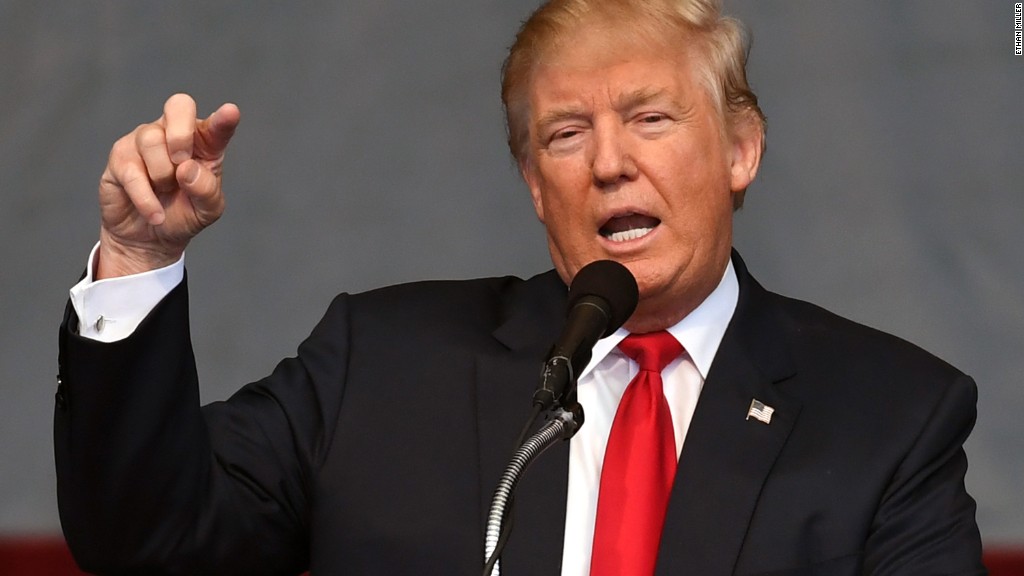
House Speaker Paul Ryan and his policy staff met Monday with Trump's top aides to review just how House Republicans want to overhaul the tax code."
Their ideas are laid out in their "Better Way" blueprint for tax reform.
They and Trump generally agree about headline changes -- e.g., streamline and simplify the code, lower tax burdens -- and they even agree on some specific measures. But there's still a lot of daylight between them on key issues.
Here are some key highlights from the House Republicans' blueprint and how they compare with Trump's latest proposals.
Cut number of tax rates
The House GOP blueprint reduces the number of tax rates from seven to three -- 12%, 25% and 33%. That's well below today's top rates of 36% and 39.6%. But the lowest rate is higher than the 10% rate in place today.
In the latest version of Trump's tax reform proposal, he raised the three individual income tax rates he'd originally proposed (10%, 20%, 25%) to conform to those in the House plan.
Raise standard deduction
Under the House GOP plan, the standard deduction would be nearly doubled, increasing to $12,000 for singles, up from $6,300 today -- and to $24,000 for married couples, up from $12,600 today.
Trump would raise the standard deduction even more, to $15,000 (or $30,000 for couples).
Kill most itemized deductions
The House plan would eliminate all itemized deductions except those for mortgage interest and charitable contributions.
Trump's plan, by contrast, keeps itemized deductions, but caps their total value at $100,000 for singles or $200,000 for joint filers, a more costly proposal.
Cut investment income taxes
Today, individuals pay up to 20% on their long-term capital gains and dividends. And their interest is taxed at ordinary income rates -- so, up to 39.6%.
House Republicans want to change that. Under their plan investors would deduct half of their gains, dividends and interest. That effectively reduces the top rate on that income to either 6%, 12.5% or 16.5%, depending on one's tax bracket.
Trump would largely leave the current investment income tax rates in place.
Lower business tax rates
When it comes to business income, the House plan would cut the corporate tax rate to 20%, down from 35% today; and reduce the tax rate on small businesses and partnerships to 25% from 39.6%.
Trump, by contrast, wants to lower the rate on all business income to 15%, again a much more expensive endeavor.
Kill taxes Republicans rail against
House Republicans want to repeal the estate tax, the Alternative Minimum Tax and key Obamacare taxes.
Trump is on board with all three repeals, but his plan would tax people's capital gains above a certain amount when they die.
Change how imports and exports are taxed
Trump has repeatedly threatened to impose tariffs on imports to protect U.S. manufacturers and entice U.S. companies to keep their domestic operations.
Ryan, meanwhile, has made repeated public comments that a measure in the House GOP blueprint might accomplish the same end without sparking a trade war.
That measure -- known as the border adjustment tax -- would fundamentally change how the U.S. government taxes imports and exports. Under the House plan, companies would no longer be able to deduct the cost of their imported goods, and the sales of their exports would no longer be subject to U.S. tax.
It's not clear yet how Trump feels about this proposal.
How much it would cost
The Tax Policy Center estimates that the House GOP blueprint would reduce revenue by $3 trillion over the first decade.
That's a big hole, but still much smaller than the one Trump's plan would create. His proposals are estimated to cost between $6 trillion and $7 trillion in the first decade.
Who gets the biggest tax breaks
The Tax Policy Center estimated that under the House GOP tax plan, taxes would drop at all income levels in 2017, but most savings would go to the highest-income households.
It reached a similar conclusion about Trump's plan.
Meanwhile, Trump's Treasury Secretary nominee Steve Mnuchin asserted that tax reform would not benefit the very rich. He claimed that "there will be no absolute tax cut for the upper class. There will be a big tax cut for the middle class, but any tax cuts we have for the upper class will be offset by less deductions."
So, stay tuned.
And don't forget, Senate Republican tax writers have yet to put out their own proposals or throw their weight behind the House plan.
-- CNN's Deirdre Walsh contributed to this report
